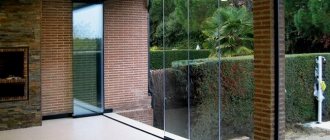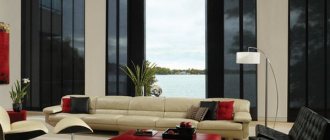If you are interested in the question of how to properly position windows in a house, then you have come to exactly the right place. In this article we will look at how to achieve optimal proportions of windows in relation to the facade. Agree, a house with windows of different sizes located at different levels will look too extravagant. For example, a window opening must be properly emphasized with decorative elements, otherwise the exterior will create a visual imbalance.
Calculation of glazing area
Why is it important to know the window area?
A window that is close to ideal is a rectangle with the correct proportions (for example: 80 cm wide and 130 cm high).
In order to make it convenient to look outside, the upper edge of the wall under the window should be no higher than 90–100 cm. In turn, the upper edge of a convenient window is at a height of about 200–220 cm from the floor and leaves enough space for attaching curtains, blinds or roller box.
How to calculate the approximate size of a window in an apartment or house
Even at the design stage, all parameters of optimal glazing for each specific room are determined. The calculations are quite complex for a non-specialist, so let’s consider their results for one living room at an angle of incidence of daylight from 18 to 30 degrees.
For comfortable lighting, the ratio of the glass area to the floor area of this room should be from 1/8 to 1/5. This means that the window will occupy an area of 14–17% of the floor area.
As for the height of the window sill. then it is determined by the purpose of the room:
- in living rooms - from 70 to 90 cm
- in work areas - from 90 to 100 cm
- in the kitchen - 125 cm
- in bathrooms and utility rooms - from 130 to 150 cm
- in dressing rooms - 175 cm.
How experts calculate glazing area
For Khrushchev
A fairly common option. Typical high-rise buildings of this type were built from 1956 to 1980. The builders offered two standard options: 5 and 9 floors. Initially it was assumed that this housing would be temporary. Its service life was limited to 20 - 50 years. By this time, the management was confident that all residents of the Khrushchev-era apartments could be moved to more comfortable apartments. However, such grandiose plans did not fully come true. Numerous Khrushchev buildings are found in large numbers in the post-Soviet space.
The window systems installed in such houses have the following dimensions:
| View | Height, mm | Width, mm |
| Bivalve | 1340 | 1280 |
| Tricuspid | 1340 | 2030 |
| Balcony block | 2030 | 2070, with door width 680 |
Determining the size of windows for the room
Windows are necessary primarily to ensure that there is sufficient light in the room during the daytime.
Since there are a large number of house designs with different room sizes and different ceiling heights, the window sizes need to be known at the design stage. In order to provide comfortable lighting, the window area should be approximately 1/8 - 1/5 of the floor area. Building regulations require that in residential premises, windows make up at least 1/10 of the floor area of that room.
Let's give an example of how to calculate the required window size. A window with an area of 17% of the floor area will be enough to provide good illumination of the entire room. The required window size in a living room is determined depending on the floor area. For example, in a room with an area of 20 sq. m window area should be calculated as follows: 20 x = 2.8 sq. m, where 0.14 is 14% of the floor area in the room.
One nuance should be noted for yourself: the closer the neighboring houses are located and the higher they are, the greater the angle of incidence of the light will be and, accordingly, the less lighting will be. Such insufficient illumination will be compensated by large window sizes. For rooms similar to residential premises, the height of windows should be no less than 1.3 m.
How to determine the height of windows and window sills? The height of the window sills directly depends on the functional purpose of the room:
- in residential premises it is 70-90 cm (in order to provide an unobstructed opportunity to view the view from the window)
- in work areas it is 90-100 cm (in order to conveniently place tables in front of the window)
- in kitchens it is 125 cm (so that work tables can be placed in front of the windows)
- in bathrooms and utility rooms it is 130-150 cm
- in dressing rooms it is 175 cm.
Formula for calculating square meters
To calculate the area, you need to apply the formula per square meter A XB, where number A is the length of one side, and number B is the length of the second side. They can be the same if the shape of the floor or wall is square.
Most often, it is not square, but rectangular, that is, number A will have one value, and number B will have another. They will need to be multiplied in your head, or using a multiplication table, or on a calculator. And the resulting number will be the area that will need to be covered with paint or something else.
It happens that the shape of the floor is not standard, but, for example, trapezoidal. Then it’s more difficult, especially for those people who don’t know what a triangle is (this also exists in nature). To calculate the size of a trapezoid, you must first calculate the area of the rectangle in the middle, then the size of each triangle on the sides, then add these three numbers. Isn't it easier to immediately call a team of workers? Let them think about how to calculate the square meters of the room.
Calculation of glazing area
What is better to know in advance?
Any home should be light and cozy. Windows provide the necessary level of illumination, add individuality, and retain heat. Therefore, even when designing a building, it is important to pay attention to its glazing.
To make your living space comfortable, despite the weather outside, it is recommended to calculate in advance the optimal ratio of the glazing area to the area of the house being built.
What current standards should you rely on when calculating windows?
When calculating the window area, you should be guided by the requirements of SNiP 2.08.01–89 “RESIDENTIAL BUILDINGS”:
"1.3. The ratio of the area of light openings of all living rooms and kitchens of apartments to the floor area of these premises should not exceed 1:5.5. The minimum ratio must be at least 1:8. For attic floors with attic windows, it is allowed to take a ratio of 1:10.”
When designing a house with standard window openings, to optimally calculate the glazing area, you should focus on the following data:
- maximum ratio of glazing area to floor area - no more than 1:5.5
- The minimum ratio of glazing area to floor area is 1:8
Example No. 1 for a village house or cottage
- The area of the house is 65 m².
Then the maximum window area will be 11.7 m². Minimum - 8.13 m²
Standard window sizes are 1500 mm × 1500 mm (2.25 m²) and 1850 mm × 1500 mm (2.78 m²)
Calculation of glazing area: 2.25·2+2.78·2=10.06 m², which optimally meets regulatory requirements
Example No. 2 for a small country house
- The area of the house is 81.5 m².
Then the window area should not exceed 14.67 m² and should be at least 10.19 m²
Calculation of glazing area: 2.0 2 + 2.37 2 + 2.93 2 = 14.6 m² - does not exceed the recommended glazing area
Simple useful tips
To avoid losing the key to the drill: To ensure that the key to the drill chuck is always at hand and is not lost, tape it to the power cord with electrical tape so that you can use it without removing it.
Mosquito lock: Mosquitoes will not fly into the room if you sprinkle a little camphor on a hot frying pan.
What are the rules abroad?
The standards for the size and area of windows in a house abroad are not so categorical, in terms of no more and no less. Actually, it’s not entirely clear why not more and not less. If these limits are set from the point of view of energy saving or protecting residents from heat stroke in the summer, then such measures are not enough. Simply limiting the area will not protect you from troubles.
In developed countries, issues such as the maximum or minimum size of glazing are considered solely from the point of view of architecture and aesthetics. Over the millennia of the formation of various architectural styles, a certain stereotype has developed regarding the relationship between the facade and the size of windows. In this case, not only the size, but also the location of the window on the facade relative to the axis is of great importance. All this, combined with the size of the building, the height of the ceilings, not just the floor area, the external decoration and style of the building, determines the size, number, shape and location of windows. There is no other approach.
Therefore, in Norway there can be houses covered with turf. With small, barely noticeable windows on the shore of the fjord, and frame, half-timbered houses with high narrow windows. Or frame and all-glass cottages. Today, everything depends on the style, aesthetics and architectural solution of the author and owner. But such glazing is always accompanied by appropriate measures to ensure comfort for residents. Chameleon glass (photochromic) or low-emission glass is used in combination with measures to insulate the walls and provide highly efficient heating devices.
Additional energy sources are used, solar energy - all this allows the use of any glazing with any area. You only need to pay attention to the glass skyscrapers of Toronto or Chicago to understand that standards for the size and area of windows in a house for countries with developed construction technologies do not exist. There are questions of expediency and style that guide them.
Why is it important to know the window area?
Windows are very specific designs. On the one hand, they provide sufficient illumination of the room, on the other hand, they are the largest “black hole” through which heat escapes to the street.
Both extremes are usually the result of errors in construction calculations or lack thereof.
According to construction rules, the minimum amount of light penetrates into a room in which the total area of all windows is 10–12.5% of the total area of the room.
In this case, not only the width and height of the window is important, but their ratio. The closer the proportion is to a harmonious rectangle, the better it is perceived visually and the more convenient it is to use.
A window that is close to ideal is a rectangle with the correct proportions (for example: 80 cm wide and 130 cm high).
Related article: How to choose a plastic window for the kitchen
In order to make it convenient to look outside, the upper edge of the wall under the window should be no higher than 90–100 cm. In turn, the upper edge of a convenient window is at a height of about cm from the floor and leaves enough space for attaching curtains, blinds or a roller shutter.
Stalinka
The construction of such houses began back in 1930 and continued until the early 1960s. The number of floors in such buildings was chosen from the range 1 – 10. Load-bearing walls were built from brick. At the same time, the ceiling height inside the room reached 3 meters. Gradually, these projects began to be abandoned in favor of more economical options.
The dimensions of the window blocks are as follows:
| View | Height, mm | Width, mm |
| Bivalve | 1950 | 1150; 1400 |
| Tricuspid | 1950 | 1700 |
| Balcony block | 2700 | 1400 |
How to calculate the approximate size of a window in an apartment or house
Even at the design stage, all parameters of optimal glazing for each specific room are determined. The calculations are quite complex for a non-specialist, so let’s consider their results for one living room at an angle of incidence of daylight from 18 to 30 degrees.
For comfortable lighting, the ratio of the glass area to the floor area of this room should be from 1/8 to 1/5. This means that the window will occupy an area of 14–17% of the floor area.
As for the height of the window sill, it is determined by the purpose of the room:
- in living rooms - from 70 to 90 cm;
- in work areas - from 90 to 100 cm;
- in the kitchen - 125 cm;
- in bathrooms and utility rooms - from 130 to 150 cm;
- in dressing rooms - 175 cm.
How experts calculate glazing area
From the point of view of designers, windows are the most vulnerable points in the building envelope. Through them there is intense energy exchange between the room and the environment.
Calculation of window area is carried out according to the methods given in SNiP (“Building Norms and Rules”). They provide illumination standards for various types of premises, corresponding coefficients and formulas.
In a simplified way, the area of light openings can be calculated based on the recommended ratios between the areas of windows and floors. These data were not taken out of thin air, but were obtained on the basis of many years of data analysis in various regions of the world.
The relevant information was summarized and compiled into easy-to-use tables.
For example, for civil buildings in the climatic conditions of the middle zone at an altitude not higher than 800 m above sea level, with slight shading by nearby buildings, the ratio of glazing area to floor area will be as follows:
- living rooms - 1/8–1/6;
- kitchens and corridors - 1/10–1/8;
- staircases - 1/14–1/10;
- classes and audiences - 1/4–1/3;
- playing and dining rooms in kindergartens - 1/4–1/3;
- hotel rooms - 1/8–1/6;
- library reading rooms - 1/6–1/5;
- offices and laboratories of the research institute - 1/7–1/5;
- administrative premises - 1/10–1/6;
- sports gymnasiums - 1/6–1/5;
- gyms - 1/5–1/4;
- medical offices - 1/7–1/5;
- hospital wards - 1/7–1/6;
- restaurant halls - 1/8–1/6;
- trading floors of stores - 1/8–1/6.
Clarifying calculation
However, these are not the only guidelines for calculating window sizes. There are other quite working methods for determining the area of light openings using special formulas, in which one of the most important parameters is also the floor area.
Today, different countries use several different methods for calculating the KEO (daylight coefficient):
- protractor method
- grid method
- ray method
- luminous flux utilization factor method
- analytical methods
They all give similar results.
How to calculate window area
For multi-apartment multi-storey buildings, as well as for standard individual construction projects, the window area in a living room is a parameter calculated by specialists in advance, and for the apartment owner it does not matter, since it already meets all norms and standards. But for developers who build their own housing from scratch, according to their own design, window area is as important a parameter as the grade of cement or the strength of concrete. The calculated glazing area helps not only to provide the correct lighting in the room - it also means the correct arrangement of furniture, and the correct calculations of the floor beam of the opening, and much more.
Window area calculation table
Conclusion
The sizes of plastic windows should be selected exclusively to fit the existing window opening. Deviations of 5–10 cm are unacceptable here; it will still not be possible to seal the voids between the frame and the wall.
Therefore, in terms of design, it is unlikely that it will be possible to develop in a city apartment or in an already built cottage. And for a private house that is just being designed, it is also better to choose standard sizes in order to save money and speed up its construction.
Non-standard products attract attention and emphasize the individuality of the facade. But they will take longer to make than standard options, and they will cost much more.
Watch also the video on how to take measurements of a plastic window:
Standards and rules
There are practical and scientifically proven standards that determine the calculation of window area, which affects other parameters of the room. Below are the fundamental extracts from several SNiPs for developers:
- SNiP 31-01-2003 determines the ratio of glazing to the total floor area for kitchen and living areas in the house - they must maintain a range of 1:5.5 - 1:8. In addition, a broader understanding of this parameter is indicated here: in low-rise buildings for the upper floors with inclined glazing (attics, attics, terraces), the ratio of the window light opening to the floor of the room should be ≥ 1:10. Also, the glazing area may vary depending on natural light and the characteristics of the window itself;
- SNiP 31-02-2001 defines the requirements for the flow of natural light through window openings in kitchens and living rooms. The optimal value of the natural light flux will be ensured by the ratio of glazing to floor area as 1:8, for attics and attics with inclined windows - as 1:10, but not less;
- SNiP 2.08.01-89 and SNiP 23-05-95 standardize the requirements for a larger group of premises for natural lighting. These are living and kitchen premises, bathrooms without sewerage, corridors and halls not directly connected to residential premises, staircases, corridors and passages in “tram” type buildings, public residential premises. In all of the listed premises, the ratio of the glazing of window openings to the floor area should be ≤ 1:5.5, taking into account that the minimum ratio is allowed as 1:8, and for attics and attics with inclined windows - 1:10.
An example of a quick calculation of glazing area
When calculating the glazing area to the floor area, we start from the following necessary steps:
- It is necessary to calculate the area of the window opening and determine the dimensions of the frame in order to find out the volume of light flux and glazing area;
- It is necessary to decide on the size and pattern of the window frame if it is not possible to use a standard pattern;
- It is necessary to work out drawings of each window indicating the exact dimensions if it is impossible to use a standard window. At the same time, the minimum glazing area is regulated by lighting standards - from SP 31-110-2003 to MGSN 2.06-99;
- The ratio of room glazing to floor area should not depend on the climatic and geographical region of the residential property, as well as on the orientation of the building to the cardinal points;
- When planning a room using windows to illuminate secondary rooms with additional light, the glazing area is calculated taking into account all areas of the rooms that will be illuminated by these light openings.
Related article: Models of plastic windows for a private home
Geometric coefficient when determining luminous flux
Requirements for luminous fluxes for a room with natural light, but artificially illuminated additionally, are determined by the area of the window opening, which should be:
- In bathrooms - 0.5 of the total floor area of the room;
- In showers and bathrooms - 0.25 of the total floor area of the room;
- In halls, vestibules and corridors - 0.16 of the total floor area of the room;
- In entrance rooms with natural light, the window opening area can be within 0.4-0.5 of the floor area of the room.
Also:
- If there are windows in a long corridor, any place on the wall opposite the window should not be closer to the window than 750 cm;
- If a long corridor is illuminated only by a window at the end of the room, then the distance of the farthest point of the wall from the window should not be greater: for northern regions 20 meters, for southern regions - 25 meters;
- If the corridor is illuminated at both ends by natural light, then its length should not exceed 55 meters.
Which sashes should I choose for a 3-hung window?
Let's look at the most common standard rectangular 3-hung window. There is a GOST requirement for the presence of non-opening sashes in the window:
| “The use of non-opening (blind) sashes in window blocks of residential buildings above the first floor is not allowed, except for sashes with dimensions not exceeding 400x800 mm, as well as in products facing balconies (loggias) if such structures have devices for ventilation of the premises... » |
This requirement is a safety requirement and must be fulfilled. Failure to comply may result in falling out when washing the window.
Photo: This method of cleaning a 3-hung window can result in a fall out resulting in serious injury or death.
The figure shows various schemes for opening a 3-hung window with a valid and invalid solution.
Photo: diagrams for opening a three-leaf window: the top row is incorrect (X), the bottom row is correct (V). In the bottom row, the 2nd option is more preferable: if you need to ventilate the room more, then it is better to install 2 sashes at once with a tilt-and-turn mode . Tilt and turn ventilation is 500 rubles more expensive than rotary ventilation, but it has more advantages.
Advantages of tilt-and-turn ventilation over rotary ventilation:
- Possibility to ventilate the apartment in a safe manner;
- You can leave the flaps folded and leave the house, provided that you use special anti-burglary strikers that maintain burglary resistance when ventilated (described below in the article);
- The sash is fixed in the folding position and will not “dangle” from the wind. There is no need to install an additional comb or “stopper” to fix the sash;
- The sash will not hit the wall slope and will not injure a person;
- Will not overcool the apartment;
Photo: ventilating a room in winter using a swing flap leads to hypothermia in the room - You can add micro-ventilation to the tilt-and-turn mode and get comfortable ventilation in winter;
- You can put a child lock or a handle with a key on the swing-out flap and calmly ventilate the apartment without threatening the child’s life;
- There is no need for vents, which increase the cost of the window and reduce the light opening;
- Less prone to sagging. The design of the tilt-and-turn sash allows it to rest when ventilating on one side on the window hinge, and on the other on the striker, which protects the sash from sagging;
- Less load on window hinges in ventilation mode, which means a longer service life.
How to calculate the main window dimensions
When designing a home, the minimum area of windows and their installation location are determined. Based on this, it is possible to calculate more accurate and specific parameters for each window of each room in order to find out the glazing area. When making calculations, it is customary to determine the maximum window height for a particular room in order to take advantage of optimal natural lighting conditions.
Taking into account the fact that the height of the window sill is 70-90 cm, and in houses with central heating 80-90 cm, and the upper lintel of the window should be no higher than 15-25 cm from the ceiling, it is easy to calculate the maximum height of the window and apply the light ratio to it parties - these calculated parameters will comply with the requirements of SNiP.
Calculation of window height from floor and ceiling
According to SNiP, with a total glazing area corresponding to 10-12% of the floor area of the room, a minimum amount of natural light will enter it. In this case, the optimal width of the window opening is considered to be corresponding to 55% of the width of the room.
The aspect ratio of the window plays more of a visual significance than a constructive one. Also, the correctly chosen aspect ratio makes it more comfortable to use the transoms. Therefore, the correct proportions are usually taken as standard ratios, for example, 8:13. There are computer programs to calculate window sizes; you can also use an online calculator.
In addition, there are rules that must be followed when making any calculations. For example, before calculating the parameters of the window and luminous flux, it is assumed that for one living space the angle of incidence of natural light through the glazing should be 18-30 0, and the glazing area should be in the range of 14-17% of the total floor area in the room .
When calculating the parameters, it is necessary to take into account neighboring buildings - the angle of incidence of the natural flow of light depends on the height of the window opening and the proximity of buildings adjacent to the dwelling. The natural flow of light will decrease as the distance between houses decreases, and vice versa. The same applies to the angle of incidence of illumination - the higher the nearby buildings, the higher the angle of light flux.
An example of finding design points
In building design, a window is considered the most vulnerable surface in terms of heat and energy exchange, therefore any standard calculations require minimizing the size of the window, which leads to a decrease in the natural light flux through the glazed area. To avoid a conflict between the desire to increase lighting and heat losses, the corresponding SNiPs have been drawn up and are in effect. Using the same recommendations, coefficients and formulas, designers carry out calculations of illumination and natural light fluxes for different rooms.
Emergency lighting angle calculation
The calculation results in the form of window aspect ratios are given below. These are examples for civil objects located in central Russia at an altitude of ≤ 800 meters above sea level, with slight shading by neighboring objects:
- Premises intended for living, including hotel rooms, restaurant and retail premises: 1:8-1:6;
- Food preparation areas and corridors: 1:10-1:8;
- Staircases and cages: 1:14-1:10;
- Educational, children's and playrooms: 1:4-1:3;
- Reading and sports halls: 1:6-1:5;
- Scientific classrooms and laboratories: 1:7-1:5;
- Administration premises: 1:10-1:6;
- Medical office premises: 1:7-1:5;
- Premises for patients – wards: 1:7-1:6;
Orientation of the building to the cardinal points
But these results of glazing areas and aspect ratios of openings, calculated using formulas, can still be considered approximate, since a separate calculation of natural lighting for each window in the room is required.
Irregularly shaped rooms
It will be much more difficult to calculate a polygonal room with your own hands. Often the layout of houses has niches, rounded elements, and triangular corners.
Technical passport of the apartment
Calculating the floor area in such cases requires first dividing it into simpler elements. For example, you have an L-shaped room - the easiest way is to divide it into 2 rectangles, calculate their sizes separately and add them up.
L-shaped room plan
Calculate the sizes of triangular elements
If the second part of the room is not located at a perpendicular angle with respect to the main part, then between the 2 rectangles there is also a triangle, the sides of which converge at right angles.
You need to additionally calculate its quadrature using the formula and add it to the total value:
For example, if a triangle has legs of 3.5 and 4.5 m: S = (3.5*4.5)/2 = 7.9 m².
Another example of how to calculate the floor area of a room with a sloping corner is shown in the photo with all dimensions.
Scheme of a bathroom with a beveled corner
To calculate the quadrature of such a room, you need to first calculate the quadrature of the rectangle, and then for the triangle, and subtract its dimensions from the total value.
Here is an example of a calculation based on the values specified in the diagram:
- Rectangle = 2.5 * 1.75 = 4.4 m2.
- Beveled triangular corner = (0.57*0.57)/2 = 0.2 m2.
- Final size = 4.4 – 0.2 = 4.2 m2.
If the triangle is not right-angled, then its calculation is done using Heron’s formula:
Heron's formula for a triangle
The symbol "p" is semi-perimeter. For example: we have a triangular shaped floor whose sides are 5, 6 and 7 meters.
Let's do the calculation for this figure:
- Find the semi-perimeter: (5+6+7)/2 = 9.
- We substitute the values into the formula: √(9 * (9-5) * (9-6) * (9-7)) = √(9 * 4 * 3 * 2) = √216 = 14.7 m2.
Calculation of rounded elements
Often, old houses have such a rounded shape near a window, or on a balcony combined with a room.
All formulas for calculating plane figures
To do this, first calculate half of the protruding part of the circle and add it to the main rectangular part.
Formula for calculation:
S = πR 2 /2, where π – 3.14, R 2 – radius of the circle squared.
For example, we have a semicircular protruding balcony with a radius of 1.5 m.
Let's substitute the numbers into the formula and find its quadrature:
S = 3.14 * 1.5 2 / 2 = 3.5 sq. m.
Sizes of window openings and room illumination
In frame buildings with strip-cut walls and strip lighting, the width of window openings determines the width of individual inserts along the axes of the supporting structure of the frame.
When designing buildings, the dimensions of window openings are set taking into account the required illumination of the premises, depending on their purpose, size, natural light in specific geographical conditions, the light characteristics of the window for a given ratio of the dimensions of the room and the window opening, the light transmittance of the window block, etc.
The area of window openings as a percentage of the area of the room is regulated by the “Building Norms and Rules” (SNiP P-A862) and is determined by the formula. SNiP P-A862 gives the normalized value of k.e.o. in the main premises of residential and public buildings located north of 45° and south of 60° northern latitude, taking into account the mandatory regular cleaning of glass at least 2 times a year for rooms with insignificant emissions of dust, smoke and soot, and four times for rooms with significant emissions.
When buildings are located south of 45° north latitude, the normalized value of k.e.o. multiplied by a factor of 0.75, and when the buildings are located north of 60° north latitude by a factor of 1.2.
For example, with side lighting in buildings located north of 45° and south of 60° north latitude c.e.o. it is 0.5 for residential premises, 1 in locker rooms and medical offices, 1.5 in school classrooms and laboratories, classrooms, assembly and sports halls, group rooms of kindergartens, dressing rooms and laboratory rooms of medical institutions, wards of maternity hospitals and 2 in hospital operating rooms.
SNiP allows deviations of ±10% of the calculated values of k.e.o. (average or minimum) from the normalized value when assigning the sizes of window openings. SNiP provides the values of the total light transmittance of the light opening t0. These values take into account the shading of the opening by supporting structures, the material and design of the binding. For example, for single binding t0 = 0.4, for double binding T0 = 0.25, for double binding t0 = 0.3.
Related article: Dormer windows pros and cons
Thus, the light transmittance of a window opening, under all equal conditions, is affected by the distance between the panes and the number of panes. Naturally, with an increase in the number of glasses and the distance between them, the light transmittance of windows worsens due to the absorption and refraction of part of the light rays. The reflectivity of walls, ceilings and floors is taken into account by the coefficient G (SNiP). With medium tones of wall decoration G = 3.0.
The effect on the illumination of the room of the darkening of window openings by opposing buildings is taken into account by the coefficient k. In new construction, if the required gaps between buildings are observed, the darkening coefficient is practically equal to 1 and can not be taken into account. The light characteristic of windows c0 depends on the ratio of the width and depth of the illuminated room B and on the ratio of its depth to the elevation H of the upper edge of the window above the conventional working plane (for example, in educational premises) or the floor (in residential premises), the value of the light characteristic c0 is given in SNiP (with a window sill height of no more than 1.2 m).
Using these values in accordance with the data of the illuminated room, it is possible to determine the value of the light characteristic of the window opening with rounded relationships between the width and length of the room and between its depth and the elevation of the upper edge of the window. To more accurately determine the intermediate values of the light characteristics of a window, the interpolation method should be used.
Measuring tools
To correctly calculate the total quadrature you will need a tool such as:
- construction tape of at least 5 meters;
- pen or pencil;
- calculator;
- building level or similar device with a scale;
- stepladder or stool;
- a sheet of paper for notes.
Prepare everything you need to measure walls. You can also use special services available on the Internet, however, their accuracy is not always correct, and for maximum accuracy it is better to do everything yourself.
Before calculating the area of the walls of the room, it is necessary to provide free access to them and move furniture away to allow unhindered movement. This is very important, because from the initial data obtained from the measurement, we obtain the total volume of the room, as well as the square footage of the ceiling and floor.
For maximum accuracy, it is recommended that before taking measurements, mark a straight line slightly above the level of the baseboards using a building level or any other long and level strip. Next, the tape measure is applied horizontally to the surface above the baseboard and the data obtained is recorded on paper. The next step is to measure the distance from the floor to the ceiling, again leaning the tape measure against the wall.
Don't forget to write down all the data you receive.
If the room has the shape of a rectangle, then to obtain the total area of the room it is enough to multiply the resulting width by the length. For example, if a wall is 5 meters long and 3 meters wide, then multiply 5 by 3 to get 15 squares.
Similarly, we measure each wall and add the resulting values into one total. For example, in a rectangular room there are 2 walls of 15 square meters and 2 of 8, we add these values 15x2=30, 8x2=16, 30+16=46. In total, the total surface area of the walls of the room was 46 squares.











